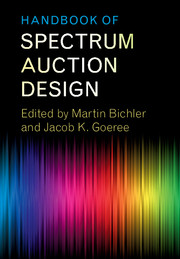Book contents
- Frontmatter
- Contents
- List of Contributors
- Preface
- List of Papers
- Part I The Simultaneous Multiple-Round Auction
- Part II The Combinatorial Clock Auction Designs
- Part III Alternative Auction Designs
- 18 A Combinatorial Auction Mechanism for Airport Time Slot Allocation
- 19 A New and Improved Design for Multi-Object Iterative Auctions
- 20 Hierarchical Package Bidding: A Paper & Pencil Combinatorial Auction
- 21 Assignment Messages and Exchanges
- 22 The Product-Mix Auction: A New Auction Design for Differentiated Goods
- 23 The Continuous Combinatorial Auction Architecture
- 24 Coalition-based Pricing in Ascending Combinatorial Auctions
- Part IV Experimental Comparisons of Auction Designs
- Part V The Bidders’ Perspective
- Part VI Secondary Markets and Exchanges
- Outlook
- References
21 - Assignment Messages and Exchanges
from Part III - Alternative Auction Designs
Published online by Cambridge University Press: 26 October 2017
- Frontmatter
- Contents
- List of Contributors
- Preface
- List of Papers
- Part I The Simultaneous Multiple-Round Auction
- Part II The Combinatorial Clock Auction Designs
- Part III Alternative Auction Designs
- 18 A Combinatorial Auction Mechanism for Airport Time Slot Allocation
- 19 A New and Improved Design for Multi-Object Iterative Auctions
- 20 Hierarchical Package Bidding: A Paper & Pencil Combinatorial Auction
- 21 Assignment Messages and Exchanges
- 22 The Product-Mix Auction: A New Auction Design for Differentiated Goods
- 23 The Continuous Combinatorial Auction Architecture
- 24 Coalition-based Pricing in Ascending Combinatorial Auctions
- Part IV Experimental Comparisons of Auction Designs
- Part V The Bidders’ Perspective
- Part VI Secondary Markets and Exchanges
- Outlook
- References
Summary
In abstract mechanism theory, the designer is often presumed able to create a direct mechanism in which each participant reports its “type,” revealing the participant's preferences along with anything else the participant may know. In practice, these details can be too numerous to report. For example, in Federal Communciations Commission (FCC) Auction No. 66 with 1,132 licenses for sale, a type includes a vector of values for every subset of licenses. Reporting that vector would have entailed reporting 21132 numbers.
One approach to mitigating the length-of-report problem is to simplify reporting by limiting the message space. The National Resident Matching Program uses this approach. It limits hospitals’ reports to a number of positions and a rank order list of candidates. If a hospital has 10 openings and interviews 50 candidates, it reports the number 10 and a list of 50—a manageably short message. In contrast, because the number of classes of 10 or fewer doctors from among 50 is about 1.3 × 1010, a general type report, including a rank order list of all those classes, would be impracticably long.
This paper introduces and analyzes a new message space—the space of assignment messages—designed for use in auctions, exchanges, and other applications where goods are substitutes. Assignment messages describe preferences indirectly as the value of a linear program for which the set of constraints is describable as a structured collection of trees or hierarchies. We show that if the constraints have this form, then the goods are substitutes, regardless of the various parameters. Conversely, if the constraints describing substitution among different goods do not respect the tree structure, then there exist parameters such that goods are not a substitutes. In that sense, the constraint structure employed by assignment messages is the most general one consistent with substitutable preferences in linear programming.
- Type
- Chapter
- Information
- Handbook of Spectrum Auction Design , pp. 443 - 461Publisher: Cambridge University PressPrint publication year: 2017

